If you buy through our links, we may earn an affiliate commission. This supports our mission to get more people active and outside.Learn about Outside Online's affiliate link policy
The 5 Best Stoves for Speedy Boil Times and Backcountry Feasts
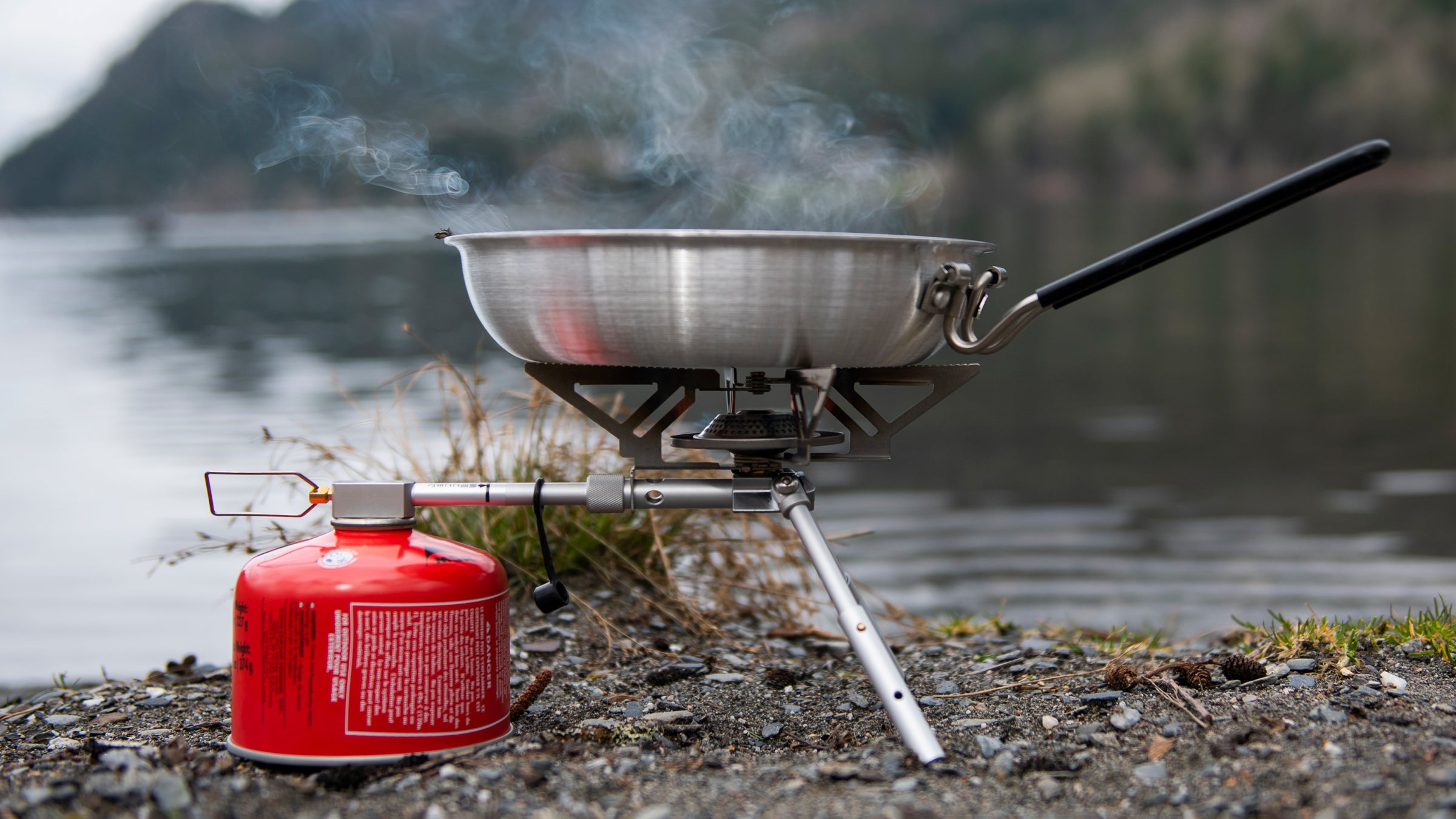
(Photo: Nick Cote)
Backpackers tend to fall into two camps: those who want to put as little time and effort as possible into a meal after a long day on the trail (boil water, add to pouch), and those for whom backcountry cooking is an essential part of the wilderness experience (what’s a few extra ounces if it means having fresh limes and hot sauce for trout tacos?). We tested backpacking stoves across the spectrum to find the very best for chefs and gram-counting pouch-lovers alike.
At a Glance
- Best Overall: Soto WindMaster Stove with 4Flex ($70)
- Best All-in-One System: Primus PrimeTech Stove System 1.3L ($200)
- Best Value: MSR PocketRocket 2 ($50)
- Best for Quick Meals: Jetboil Flash 1.0L Fast Boil System ($130)
- Most Stable Canister Stove: Snow Peak BiPod Stove ($80)
- Other Products We Tested
- How to Choose a Backpacking Stove
- How We Test
- Meet Our Testers
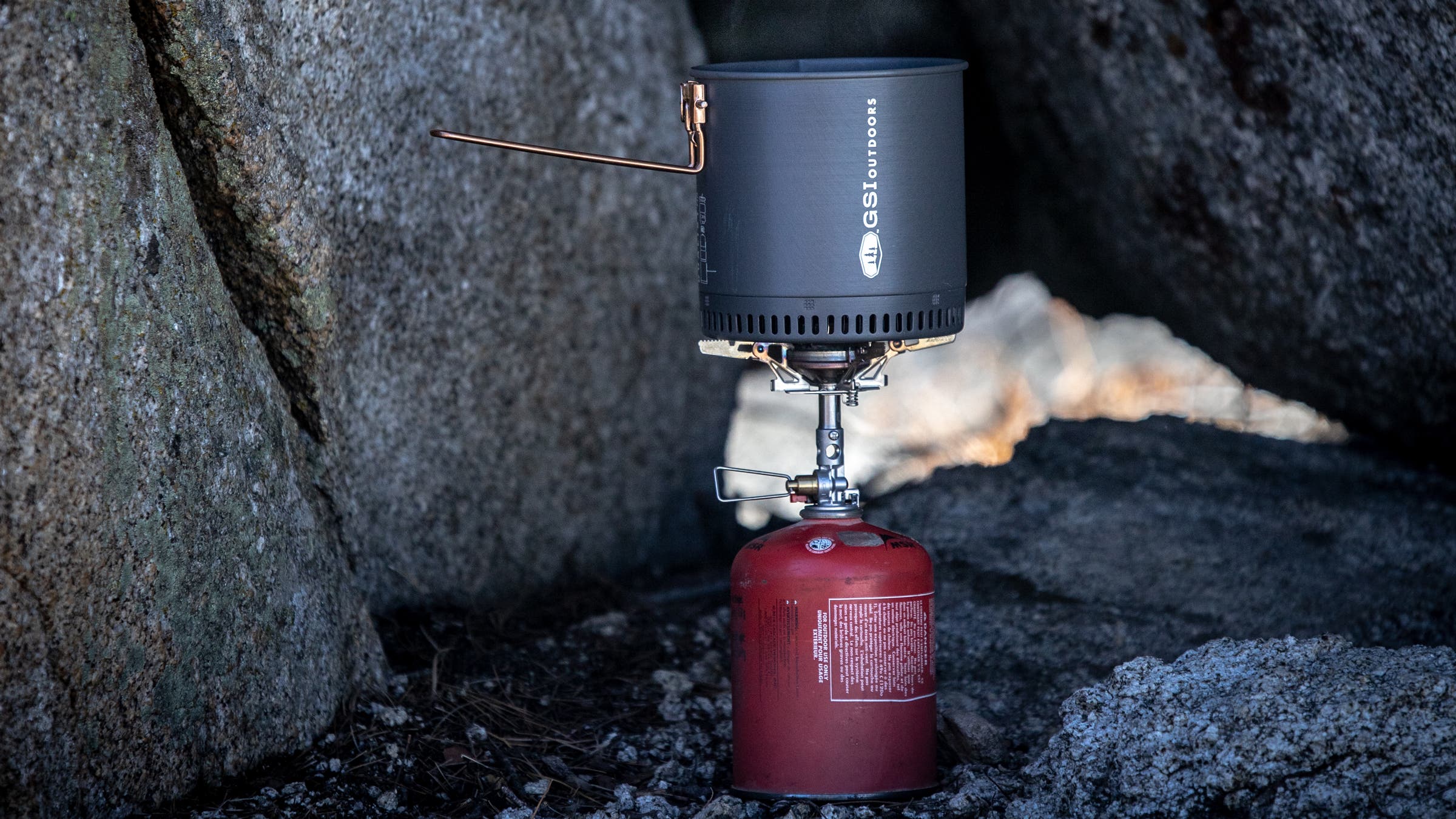
Best Overall
Soto WindMaster Stove with 4Flex
Weight: 3 oz
Tested boil time (1 L): 2.5 minutes
Lab Score (1-5): 0 mph Wind: 4
Lab Score (1-5): 5 mph Wind: 4
Lab Score (1-5): 10 mph Wind: 3
Pros and Cons
⊕ Light and compact
⊕ Efficient
⊕ Wind-resistant
⊕ Good simmer control
⊗ Detachable pot supports easy to lose
Canister-style stoves are some of the most compact, lightweight, and budget-friendly options on the market. And while most perform adequately at a lower price point than the WindMaster, Soto’s petite burner is leagues beyond most of the competition.
Pumping out 11,000 BTU/h, it’s one of the most powerful stoves we tested, capable of boiling 1 liter of water in under 3 minutes. The kicker? It can do that during a storm, like the one our testers weathered in western Washington with sustained 20 to 30 mile-per-hour winds. That’s thanks to the concave design of the burner and its position close to the bottom of the pot, effectively sheltering the flame from the elements.
And while most canister stoves are somewhat unwieldy with large or heavy pots, the WindMaster’s four-armed, collapsible base offered more stability than any of the other canister stoves we tested, comfortably handling up to a 3 liter pot. Soto offers a three-armed support—the TriFlex, sold separately for $10.45—but we found saving 20 grams of weight wasn’t worth the extra precariousness. The built-in ignitor fired up reliably with the push of a button, eliminating the need to carry a lighter. These factors, combined with its ability to hold a steady simmer, make the WindMaster a simple, reliable stove that can handle any task.

Best All-in-One System
Primus PrimeTech Stove System 1.3L
Weight: 2.3 lbs
Tested boil time (1 L): 3.5 minutes
Lab Score (1-5): 0 mph Wind : 4/5 (aluminum pot/heat exchange pot)
Lab Score (1-5): 5 mph Wind: 3/5 (aluminum pot/heat exchange pot)
Lab Score (1-5): 10 mph Wind: 2/2 (aluminum pot/heat exchange pot)
Pros and Cons
⊕ Stable
⊕ Good simmer control
⊕ Big enough for groups
⊕ Big enough for large pots
⊗ Heavy and bulky
⊗ Separate Piezo igniter
If boiling water is all that matters to you, this isn’t your stove. But if you’re the type that relishes in planning and executing delicious backcountry meals, the PrimeTech 1.3L system is the best tool I’ve found for the job over five years of testing.
While the stove will accommodate a wide range of cookware, the included aluminum Primus pots are particularly well-designed. One has an integrated heat exchanger—a corrugated metal band along the bottom of the pot—that vastly improves heat transfer and is ideal for boiling water or heating soups quickly. The other comes without a heat exchanger but has a nonstick coating, making it well-suited for sautéing or cooking foods that have a tendency to stick (I’m looking at you, mac and cheese).
A lid with a built-in strainer serves both pots, and everything nests tidily together. The sturdy aluminum pot gripper is built strong enough to handle very heavy pots of hot food.
This stove is a bit of a brute, but with that comes a few advantages for cheffy backpackers. First, the pot sits neatly in place on the wide stove basin, sheltering it from the wind and making it incredibly stable. Second, the large burner distributes heat evenly, making it easier to maintain a simmer or sauté fresh ingredients. This came in handy on a trip into Montana’s Flathead National Forest, where soba noodles with tofu were on the menu. I put a nice sear on the tofu, then simmered the noodles gently in a broth until perfectly tender—a big step up from throwing everything into the pot and hoping for the best. The Primetech Stove System 1.3L lands in the middle of the pack as far as power output, with 6,824 BTU/h, but the regulated valve offers great adjustability and fuel efficiency.
These benefits do come at a cost: The whole setup weighs just over two pounds and occupies a decent amount of real estate in a backpack, measuring 7 by 4 inches when all packed up. That said, with the meals you’ll be making, it won’t be hard to find a food-motivated friend to help share the load.
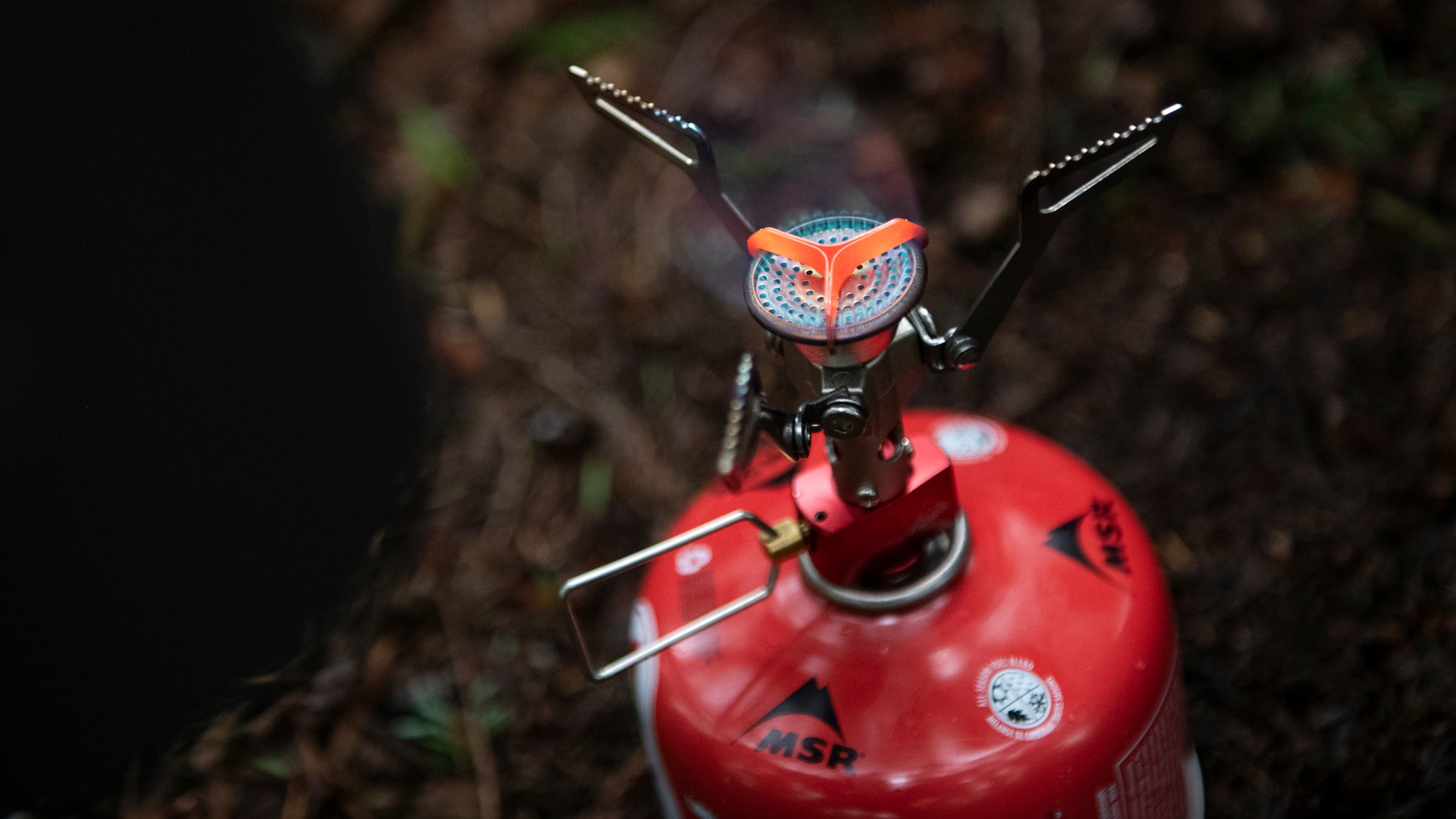
Best Value
MSR PocketRocket 2
Weight: 2.6 oz
Tested boil time (1 L): 3.5 minutes
Lab Score (1-5): 0 mph Wind: 3
Lab Score (1-5): 5 mph Wind: 3
Lab Score (1-5): 10 mph Wind: 1
Pros and Cons
⊕ Light and compact
⊕ Budget-friendly
⊗ Unstable
⊗ Poor wind performance
Most career backpackers have owned at least one version of the PocketRocket, which has been around since the turn of the millennium, at some point in their lives. It’s relatively cheap, can withstand some neglect (we’ve accidentally left it out overnight in the rain), and performs well enough for hot water and meals that don’t require nuance. At or around sea level, we found its output reliably strong, consistently bringing a liter of water to boil around the four minute mark. Though the flame is easily adjustable and can maintain a simmer decently well, it’s held back by the small diameter of the burner head, making this stove better suited for narrow pots and boiling tasks. There are no bells or whistles, but there’s beauty in its simplicity. And its 3-by-1.7-inch form factor makes it one of the most compact stoves on the market. When stacked up against our top pick (the Soto WindMaster), it falls short due its lack of a built-in ignitor, wind-resistance, versatility, and pot stability, but outperforms any other canister-style stove we tested at this price point.
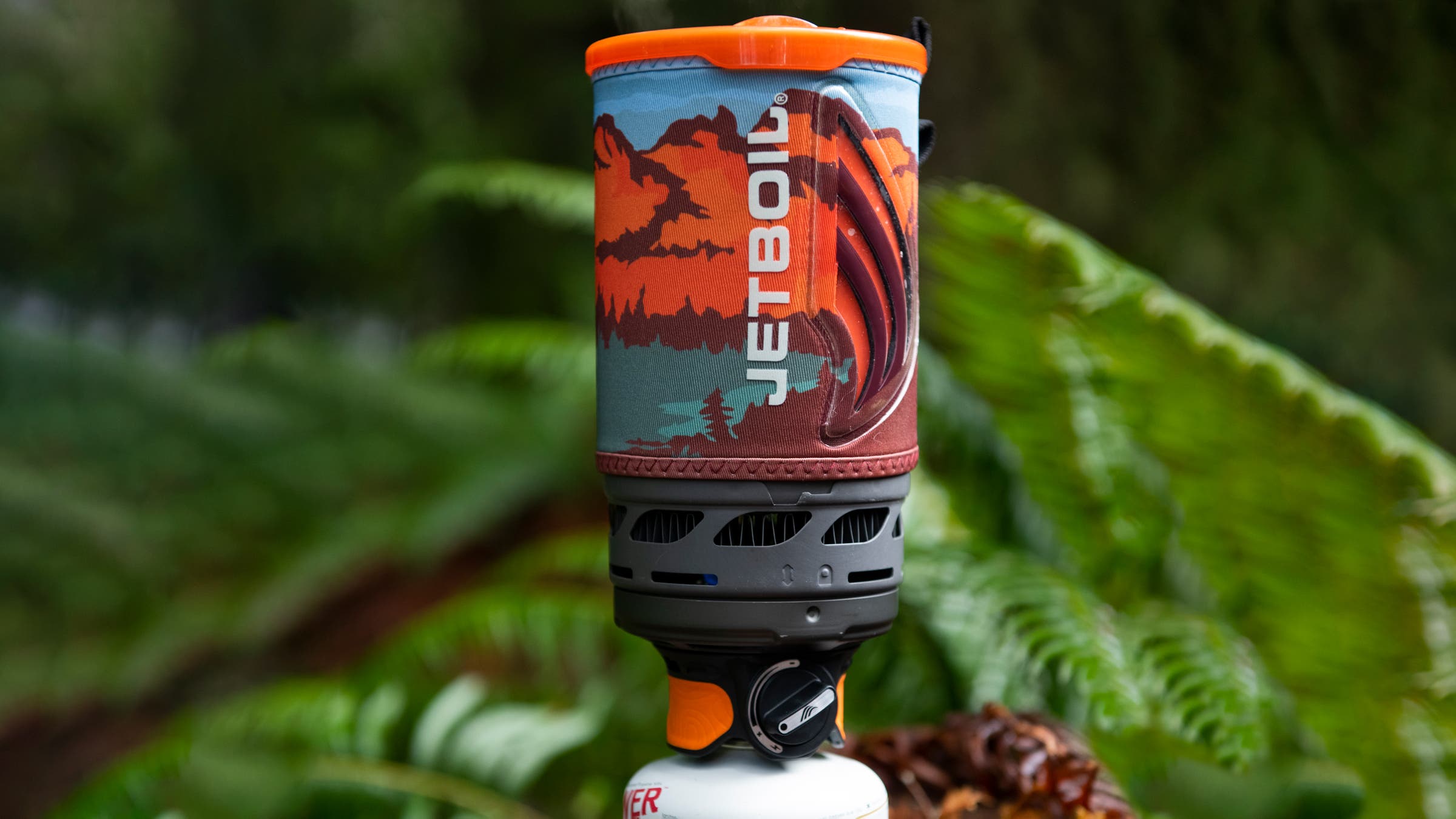
Best for Quick Meals
Jetboil Flash 1.0L Fast Boil System
Weight: 13 oz
Tested boil time (1 L): 2 minutes
Lab Score (1-5): 0 mph Wind: 5
Lab Score (1-5): 5 mph Wind: 4
Lab Score (1-5): 10 mph Wind: 5
Pros and Cons
⊕ Compact
⊕ Efficient
⊕ Lightning-fast
⊕ Stable
⊕ Insulated sleeve with color-changing heat indicator
⊗ Accessories not included
When it comes down to outright speed, the aptly-named Jetboil Flash 1.0L is the clear winner with a blistering boil time of just two minutes-per-liter. That’s thanks to a corrugated heat exchanger at the bottom of the pot wrapped in a perforated wind guard—both of which save time and fuel.
Not only is it blazing-fast, it’s one of the easiest-to-use stoves on the market. The latest generation adds a nifty ignitor/adjuster knob to the bottom half of the stove, functioning in a similar manner to a burner in your home kitchen—just turn and ignite. Like previous generations, the insulated sleeve not only allows you to easily handle boiling liquids, but changes color when it’s hot, and the redesigned grip keeps your hands safe when handling hot liquids. The tall profile of the integrated stove can feel slightly precarious, but an included base support snaps onto the bottom of the fuel canister, adding some much-needed stability. If you’re accident prone, this stove is about as idiot-proof as it gets.
Out of the box, the Flash 1.0L is mostly limited to quickly heating liquids, but its full potential can be reached with a few accessories. Flat-bottomed pots and skillets can be used with the addition of the Pot Support 2.0 ($11), which folds out and attaches to the burner. (The three-armed support is narrow, making it suitable only for smaller pots.) Coffee lovers can spring for the Flash Java 1.0L ($145), which adds a French Press plunger, or buy the plunger separately ($15).
Even when carrying a more robust kitchen setup, I try to find room in my pack (or better yet, a friend’s) to bring the Flash 1.0L for a quick cup of coffee or a hot meal during early morning starts. If you’re a dedicated coffee drinker or dehydrated meal connoisseur, you won’t find a faster or simpler way to boil water in the backcountry.
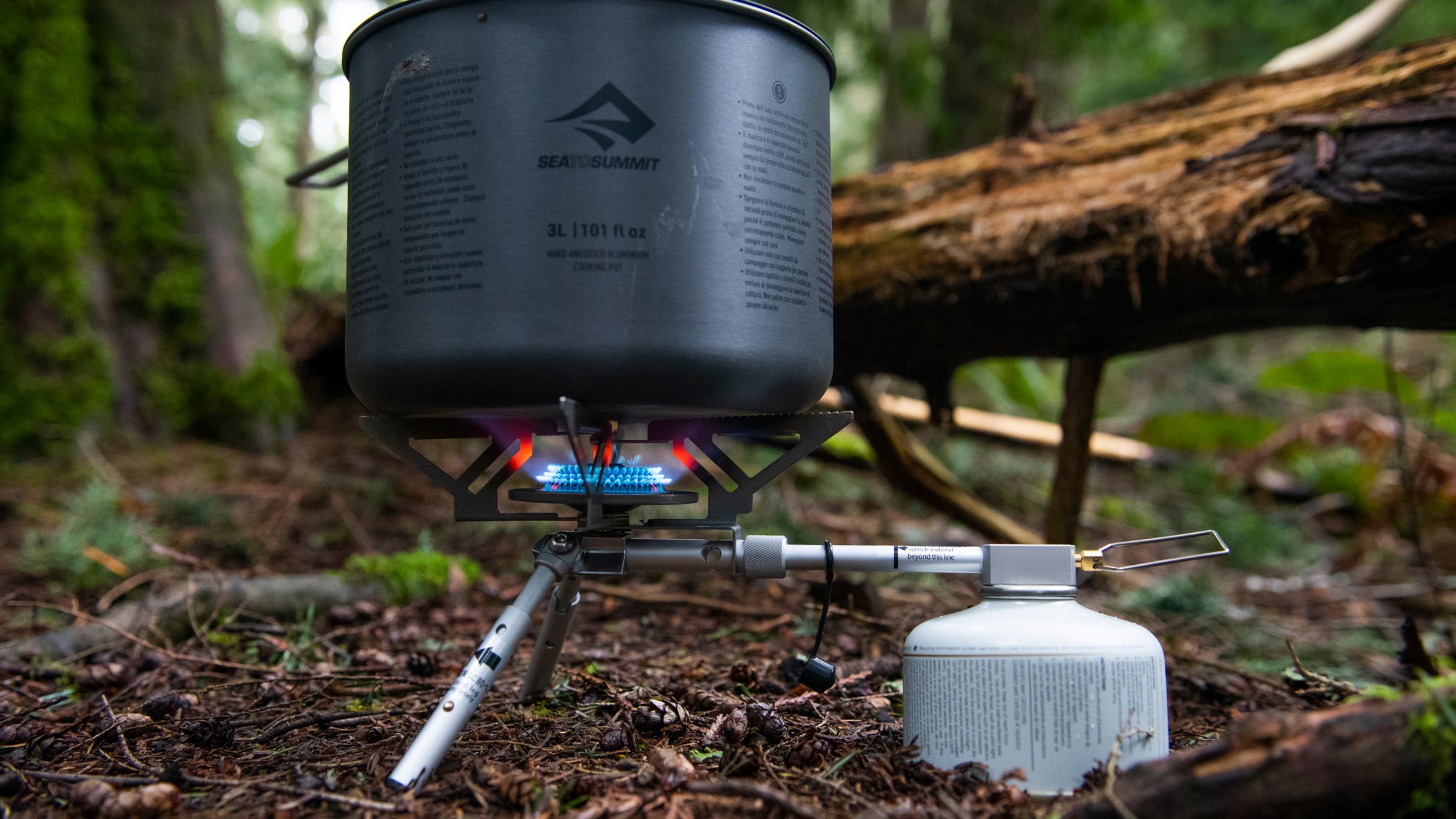
Most Stable Canister Stove
Snow Peak BiPod Stove
Weight: 8.3 oz.
Tested boil time (1 L): 4 minutes
Lab Score (1-5): 0 mph Wind: 3
Lab Score (1-5): 5 mph Wind: 1
Lab Score (1-5): 0 mph Wind: 1
Pros and Cons
⊕ Stable
⊕ Powerful
⊕ Folds up neatly
⊕ Good simmer control
⊗ No built-in ignitor
By far the funkiest stove we tested, the Snow Peak BiPod’s unique design quickly converted the skeptics among us. Most canister stoves either screw right on top of the fuel or connect to it remotely via a flexible hose. The BiPod forges a new path, using two legs plus a rigid connector that turns the canister itself into a third leg. This configuration boasts both a low center of gravity and a super-wide base, so our testers never worried about large pots tipping over in winds up to 25 miles-per-hour. And the arms fold out to a full 7-inches-wide—tied with the Primus PrimeTech system for the widest cooking platform.
On a group trip in Olympic National Park, this stove could easily handle a full 3 liter pot, big enough to feed the whole group, eliminating the need to cook in batches or bring extra gear. The burner is among the most powerful in the test with an 11,600 BTU/h output, yet it can still maintain a simmer for nuanced cooking, like slowly heating a pot of chili. The wide burner head also helps in this regard, distributing the flame over a larger area and making it less prone to hot spots.
Setup is a breeze, with adjustable legs to accommodate differently-sized fuel canisters. It’s not as compact as a canister-style stove, but folds up to about the size of a soda can—much smaller than comparably sturdy cook setups. And even with its stainless steel and aluminum alloy build, the BiPod clocks in at a reasonable half pound, with strong points for durability.
Our chief complaint? We wish it had a built-in ignitor, but that’s a small oversight outweighed by this stove’s many other benefits. When it comes to stability and precise modulation, this stove’s design sits at the top of its class.
Other Products We Tested
Throughout our test there were some clear favorites, though many of our picks won out by a razor-thin margin. Often the edge was given to the winners over a matter of a few ounces or minor preferences in a product’s design or ease of use. Here are the stoves that fell just short of earning a spot on our list.
- Primus Ulti Stove System (1 L) ($235): Testers liked the remote fuel attachment for its added stability, but ultimately the Jetboil Fast Boil performed better and weighed less.
- MSR Whisperlite International ($160): If traveling internationally or sourcing fuel is a concern, the MSR Whisperlite is a reliable and versatile option. Using a refillable fuel canister, backpackers have the option of using kerosene, white gas, and even unleaded gasoline—all widely available fuel sources.
- BRS 3000T Titanium Alloy Stove ($17): A compact, lightweight canister stove at an incredible price—but not without its flaws, including poor fuel efficiency and simmer control.
- MSR PocketRocket Deluxe ($85): In terms of performance, this stove is a solid competitor against the Soto Windmaster. But the pot support isn’t as sturdy as the Windmaster’s 4Plex system and it’s among the most expensive canister-style stoves we tested.
- MSR Switch ($140): New for 2025, this system is similar in form and function to the Jetboil Fast Boil and Primus Ulti and Lite stoves. It’s a great system, though the pot doesn’t lock into place, making it more precarious to use than its direct competitors.
- GSI Pinnacle 4 Season Stove ($80): This is a good option for those who prefer remote canister setups, though when stacked up against the competition, it fell squarely in the middle of the pack in terms of weight and performance.
- MSR Reactor Stove System ($270): This stove boils water quickly, even in nasty weather. That said, there are other stoves that can do the same job—or better—for a fraction of the price. Testers also disliked that the stove remained hot for a long time, doesn’t have a built-in ignitor, is heavy, and doesn’t feature a locking system for the pot.
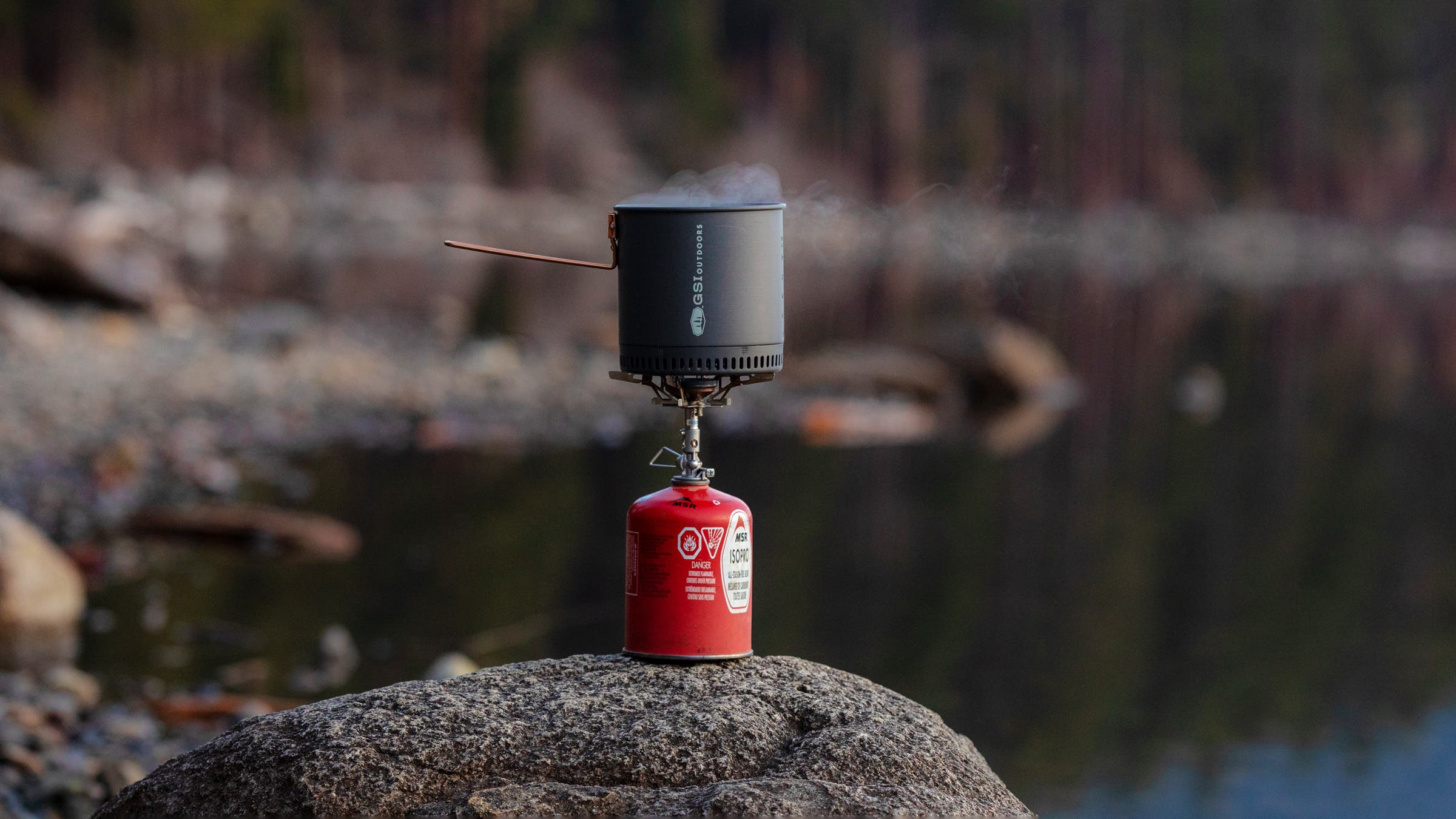
How to Choose a Backpacking Stove
Cooking Style: How much time and effort you’re willing to spend cooking is one of the most important factors when choosing a stove. If you’d rather put your energy into maximizing time on the trail or relaxing in camp, going with a system that simply boils water quickly, like a Jetboil or wind-resistant canister stove, is likely your best option. If you like to get cheffy, consider stoves that work well with a wide range of pots and pans and offer more simmer control and stability.
Size and Weight: Of course we’d all rather have a lighter pack, but cutting weight usually means sacrificing performance elsewhere. How much you’re willing to sacrifice is entirely personal, but shaving a few ounces often comes at the cost of heat transfer, user-friendliness, and durability. If you’re cooking for a group, we’d recommend using a remote canister-style stove, which is better suited to larger and heavier pots. For unhurried solo backpackers mostly focused on boiling water for dehydrated meals, a 2- to 3-ounce canister stove is just the ticket.
Output: Your stove’s output impacts cooking time, fuel efficiency, and adaptability in various conditions. Higher-output stoves boil water faster and perform better in cold, windy, and high altitude settings, but they consume more fuel at full crank. High-output stoves with precise temperature modulation are the best of both worlds.
Fuel Type: The two most common fuel options on-trail are isobutane canisters and white gas/liquid fuel. Most backpackers use “iso” canisters for convenience (they’re recyclable once empty.) White gas canisters are refillable and perform better at altitude and in cold temperatures, although they’re heavy, expensive, and less convenient than canister stoves. You may see some nontraditionalists using twigs, Esbit tablets, or denatured alcohol for fuel. These are best left to the gram-counters.
Materials: The best material for cookware depends on your cooking needs, weight preferences, and budget. The three most common are:
- Titanium: The lightest and most expensive material for stoves.
- Aluminum: For most backpackers, this is the best option. It’s slightly heavier than titanium, but at a lower price point.
- Stainless Steel: Heavy but incredibly durable, stainless steel is overkill for most backpackers. Unless you have a knack for destroying cookware, aluminum will likely meet your needs just fine.
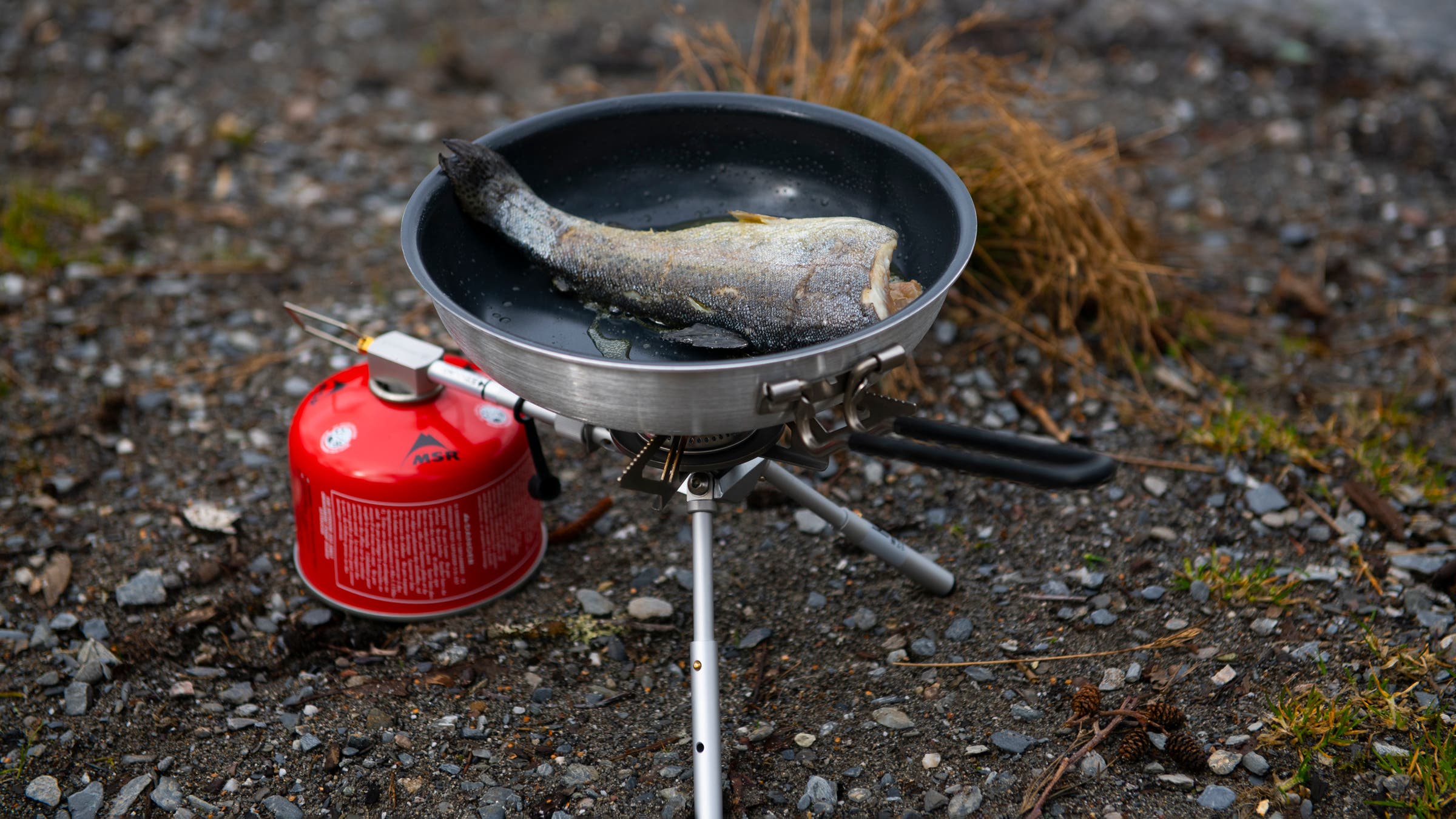
How We Test Stoves in the Field
- Products tested: 17
- Testers: 5
- Highest elevation: 11,580 ft.
- Strongest wind: 50 mph gusts
- Trout cooked: 15
- Largest group meal: 6 diners
Each summer we test new and updated products against the old standards across the Pacific Northwest, California, and Colorado. Before the stoves headed out to their testers, I established baseline boiling times on a calm, overcast day with 60-degree weather at sea level. We then compared those baselines against the numbers our testers experienced in varied climates and weather conditions to account for how well they handle altitude, wind, and temperature.
Our testers ranged from beginner/intermediate cooks who prefer an efficient, no-fuss setup to those who wouldn’t think of leaving home without a spice jar. Factors we considered that made our top picks stand out were size and weight, ease of use, fuel type and efficiency, stability, versatility, durability, and budget. Some products stood out for being able to handle a wide range of tasks reasonably well, while others excelled at just one thing.
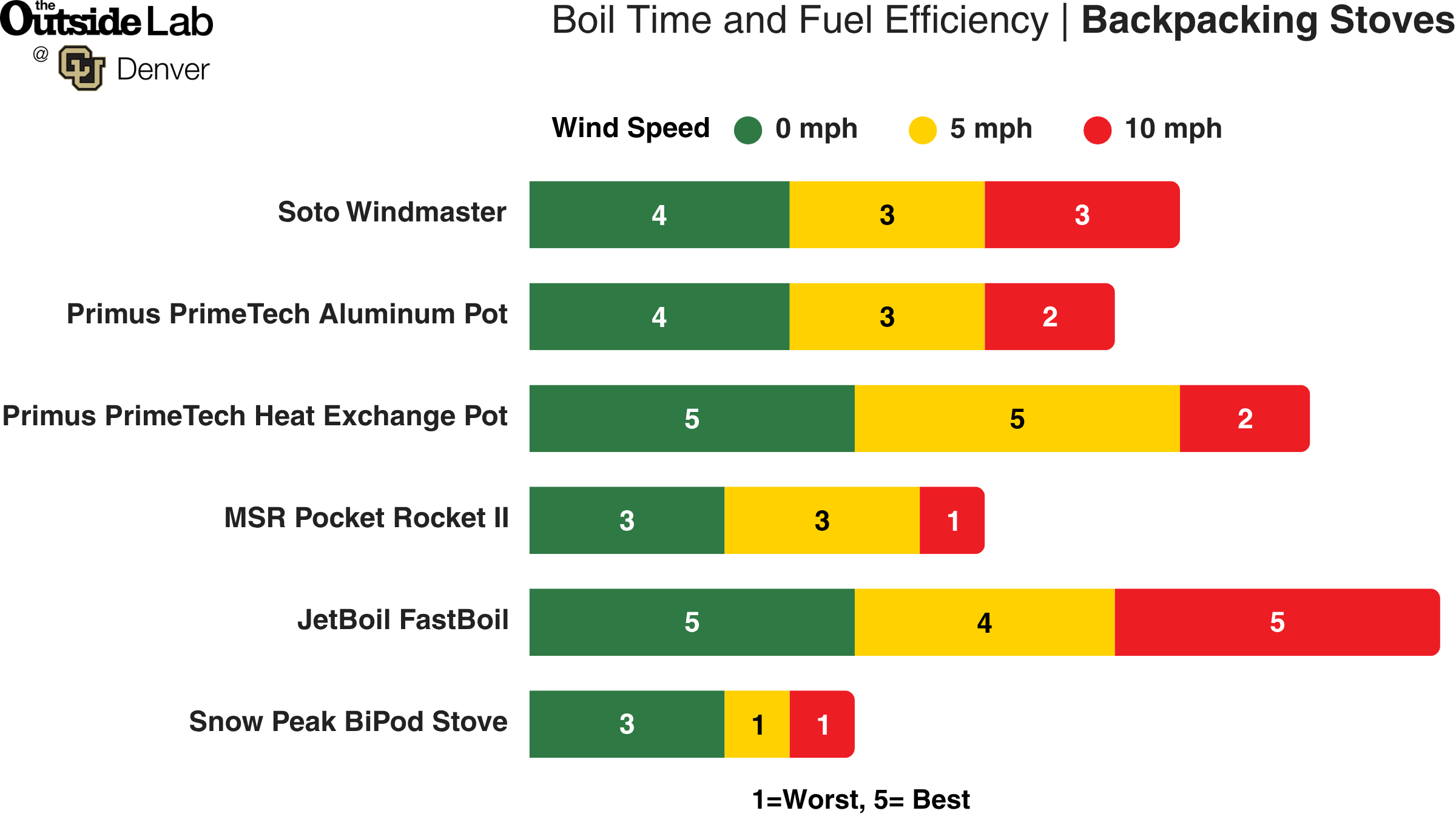
How We Test Stoves in the Outside Lab
Effect of Windy Conditions
To test backpacking stoves in the Outside Lab, we looked at how long it took to boil water in windy conditions, and how fuel-efficient the stoves were in the process. Each stove was first tested in a wind-free environment, with a controlled ambient temperature range of 60-70 degrees, to set a baseline. The boil test was then performed under increasingly windy conditions using a fan set to five and ten miles per hour directed at the flame. Wind speed was verified using an anemometer (a tool that measures wind speed) next to the burner. Approximately 70-degree water was used for each test, and burners were turned to their maximum on position. To determine stove efficiency, we weighed the fuel can before and after each boil cycle.
A score of 1 to 5, worst to best, was given for each test based on a combination of the boil time and fuel efficiency.
Meet Our Testers
Nick Cote is a photographer and writer based in Bellingham, Washington. He is the author of Wild Eats: Campsite Cooking and is a frequent recipe contributor to Backpacker. His work has also been published in The New York Times, The Washington Post, The Wall Street Journal, Outside, and many others.
Dylan Warren is a wandering photographer in constant pursuit of deep snow and good dirt. His adventures have taken him from New York to Alaska and everywhere in between. When he settles down he splits his time between Lake Tahoe, Bellingham, and New York City.